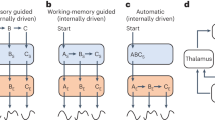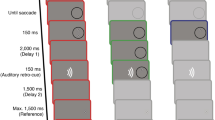Abstract
To investigate the functional role of the striatum in visuo-motor adaptation, we extend the DIRECT-model for visuo-motor reaching movements formulated by Bullock et al.(J Cogn Neurosci 5:408–435,1993) through two parallel loops, each modeling a distinct contribution of the cortico–cerebellar–thalamo–cortical and the cortico–striato–thalamo–cortical networks to visuo-motor adaptation. Based on evidence of Robertson and Miall(Neuroreport 10(5): 1029–1034, 1999), we implement the function of the cortico–cerebellar–thalamo–cortical loop as a module that gradually adapts to small changes in sensorimotor relationships. The cortico–striato–thalamo–cortical loop on the other hand is hypothesized to act as an adaptive search element, guessing new sensorimotor-transformations and reinforcing successful guesses while punishing unsuccessful ones. In a first step, we show that the model reproduces trajectories and error curves of healthy subjects in a two dimensional center-out reaching task with rotated screen cursor visual feedback. In a second step, we disable learning processes in the cortico–striato– thalamo–cortical loop to simulate subjects with Parkinson’s disease (PD), and show that this leads to error curves typical of subjects with PD. We conclude that the results support our hypothesis, i.e., that the role of the cortico–striato–thalamo–cortical loop in visuo-motor adaptation is that of an adaptive search element.
Similar content being viewed by others
References
Andersen RA, Buneo CA (2002) Intentional maps in posterior parietal cortex. Annu Rev Neurosci 25:189–220
Balslev D, Nielsen FA, Frutiger SA, Sidtis JJ, Christiansen TB, Svarer C, Strother SC, Rottenberg DA, Hansen LK, Paulson OB, Law I (2002) Cluster analysis of activity-time series in motor learning. Hum Brain Map 15(3):135–145
Buch ER, Young S, Contreras-Vidal JL (2003) Visuomotor adaptation in normal aging. Learn Memory 10(1):55–63
Bullock D, Grossberg S (1988) Neural dynamics of planned arm movements: emergent invariants and speed-accuracy properties during trajectory formation. Psychol Rev 95:49–90
Bullock D, Grossberg S, Guenther FH (1993) A self-organizing neural model of motor equivalent reaching and tool use by a multijoint arm. J Cogn Neurosci 5:408–435
Burnod Y, Baraduc A, Battaglia-Mayer A, Guigon E, Koechlin E, Ferraina S, Lacquaniti F, Caminiti R (1999) Parieto-frontal coding of reaching: an integrated framework. Exp Brain Res 129:325–346
Clower DM, Hoffman JM, Votaw JR, Faber TL, Woods RP, Alexander GE (1996) Role of posterior parietal cortex in the recalibration of visually guided reaching. Nature 383:618–621
Contreras-Vidal JL, Buch ER (2003) Effects of Parkinson’s disease on visuo-motor adaptation. Exp Brain Res 150:25–32
Contreras-Vidal JL, Kerick SE (2004) Independent component analysis of dynamic brain responses during visuomotor adaptation. Neuroimage 21(3):936–945
Cunningham HA (1989) Aiming error under transformed spatial mappings suggests a structure for visual-motor maps. J Exp Psychol Hum Percept Perform 15:493–506
Doya K (2000) Complementary roles of basal ganglia and cerebellum in learning and motor control. Curr Opin Neurobiol 10:732–739
Doyon J, Penhune V, Ungerleider LG(2003) Distinct contribution of the cortico-striatal and cortico-cerebellar systems to motor skill learning. Neuropsychologica 41(3):252–262
Fahn S, Sulzer D (2004) Neurodegeneration and neuroprotection in Parkinson disease. NeuroRx 1(1):139–154
Ghilardi MF, Ghez C, Dhawan V, Moeller J, Mentis M, Nakamura T, Antonini A, Eidelberg D(2000) Patterns of regional brain activation associated with different forms of motor learning. Brain Res 871:127–145
Guigon E, Baraduc P (2002) A neural model of perceptual-motor alignment. J Cogn Neurosci 14:538–549
Imamizu H, Miyauchi S, Tamada T, Sasaki Y, Takino R, Putz B, Yoshioka T, Kawato M(2000) Human cerebellar activity reflecting an acquired internal model of a new tool. Nature 403:192–195
Ingram HA, van Donkelaar P, Cole J, Vercher JL, Gauthier GM, Miall RC(2000) The role of proprioception and attention in a visuomotor adaptation task. Exp Brain Res 132:114–126
Inoue K, Kawashima R, Satoh K, Kinomura S, Sugiura M, Goto R, Ito M, Fukuda H (2000) A PET study of visuomotor learning under optical rotation. Neuroimage 11:505–516
Inoue K,Kawashima R, Sugiura M, Ogawa A, Schormann T, Zilles K, Fukuda F(2001) Activation in the ipsilateral posterior parietal cortex during tool use: a PET study. Neuroimage 14:1469–1475
Kagerer FA, Contreras-Vidal Jl, Stelmach GE (1997) Adaptation to gradual as compared with sudden visuo-motor distortions. Exp Brain Res 115:557–561
Kish SJ, Shannak K, Hornykiewicz O (1988) Uneven pattern of dopamine loss in the striatum of patients with idiopathic Parkinson’s disease, pathophysiologic and clinical implications. New England J Med 318(14):876–880
Koerding K, Wolpert DM (2004) Bayesian integration in sensorimotor learning. Nature 427:244–247
Krakauer JW, Ghilardi MF, Mentis M, Barnes A, Veytsman M, Eidelberg D, Ghez C (2004) Differential cortical and subcortical activations in learning rotations and gains for reaching: a PET study. J Neurophysiol 91:924–933
Krakauer JW, Pine ZM, Ghilardi MF, Ghez C (2000) Learning of visuomotor transformations for vectorial planning of reaching trajectories. J Neurosci 20(23):8916–8924
Krebs HI, Brashers-Krug T, Rauch SL, Savage CR, Hogan N, Rubin RH, Fischman AJ, Alpert NM (1998) Robot-aided functional imaging: application to a motor learning study. Hum Brain Map 6:59–72
Krebs HI, Hogan N, Heing W, Adamovich SV, Poizner H (2001) Procedural motor learning in Parkinson’s disease. Exp Brain Res 141:425–437
Laforce Jr R, Doyon J (2002) Differential role for the striatum and cerebellum in response to novel movements using a motor learning paradigm. Neuropsychologia 40:512–517
Nakahara H,Doya K, Hiskosaka O (2001) Parallel cortico-basal ganglia mechanisms for acquisition and execution of visuomotor sequences - a computational approach. J Cogn Neurosci 13(5):626–647
Pine ZM, Krakauer J, Gordon J, Ghez C (1996) Learning of scaling factors and reference axes for reaching movements. Neuroreport 7:2357–2361
Robertson EM, Miall RC (1999) Visuomotor adaptation during inactivation of the dentate nucleus. Neuroreport 10(5):1029–1034
Roby-Brami A, Burnod Y (1995) Learning a new visuomotor transformation: error correction and generalization. Cogni Brain Res 2:229–242
Rosenbaum DA,Engelbrecht SE, Bushe MM,Loukopoulos LD (1993) A model for reaching control. Acta Psychologica 82(1–3):237–250
Schultz W,Dayan P, Montague PR (1997) A neural substrate of prediction and reward. Science 275:1593–1599
Seidler RD, Noll DC, Chintalapati P (2006) Bilateral basal ganglia activation associated with sensorimotor adaptation. Exp Brain Res (in press)
Shadmehr R, Holcomb HH (1997) Neural correlates of motor memory consolidation. Science 277:821–825
Smith MA, Shadmehr R (2005) Intact ability to learn internal models of arm dynamics in Huntington’s disease but not cerebellar degeneration. J Neurophysiol 93:2809–2821
Stoffers D, Berendse HW, Deijen JB, Wolters EC (2002) The of computer experience on visuo-motor control: implications for visuo-motor testing in Parkinson’s disease. Neuropsychologica 40(11):1779–1785
Teulings HL, Contreras-Vidal JL, Stelmach GE, Adler CH (2002) Handwriting size adaptation under distorted visual feedback in Parkinson’s disease patients, elderly controls and young controls. J Neurol Neurosurg and Psychiat 72:315–324
Author information
Authors and Affiliations
Corresponding author
Rights and permissions
About this article
Cite this article
Grosse-Wentrup, M., Contreras-Vidal, J.L. The role of the striatum in adaptation learning: a computational model. Biol Cybern 96, 377–388 (2007). https://doi.org/10.1007/s00422-007-0142-8
Received:
Accepted:
Published:
Issue Date:
DOI: https://doi.org/10.1007/s00422-007-0142-8




